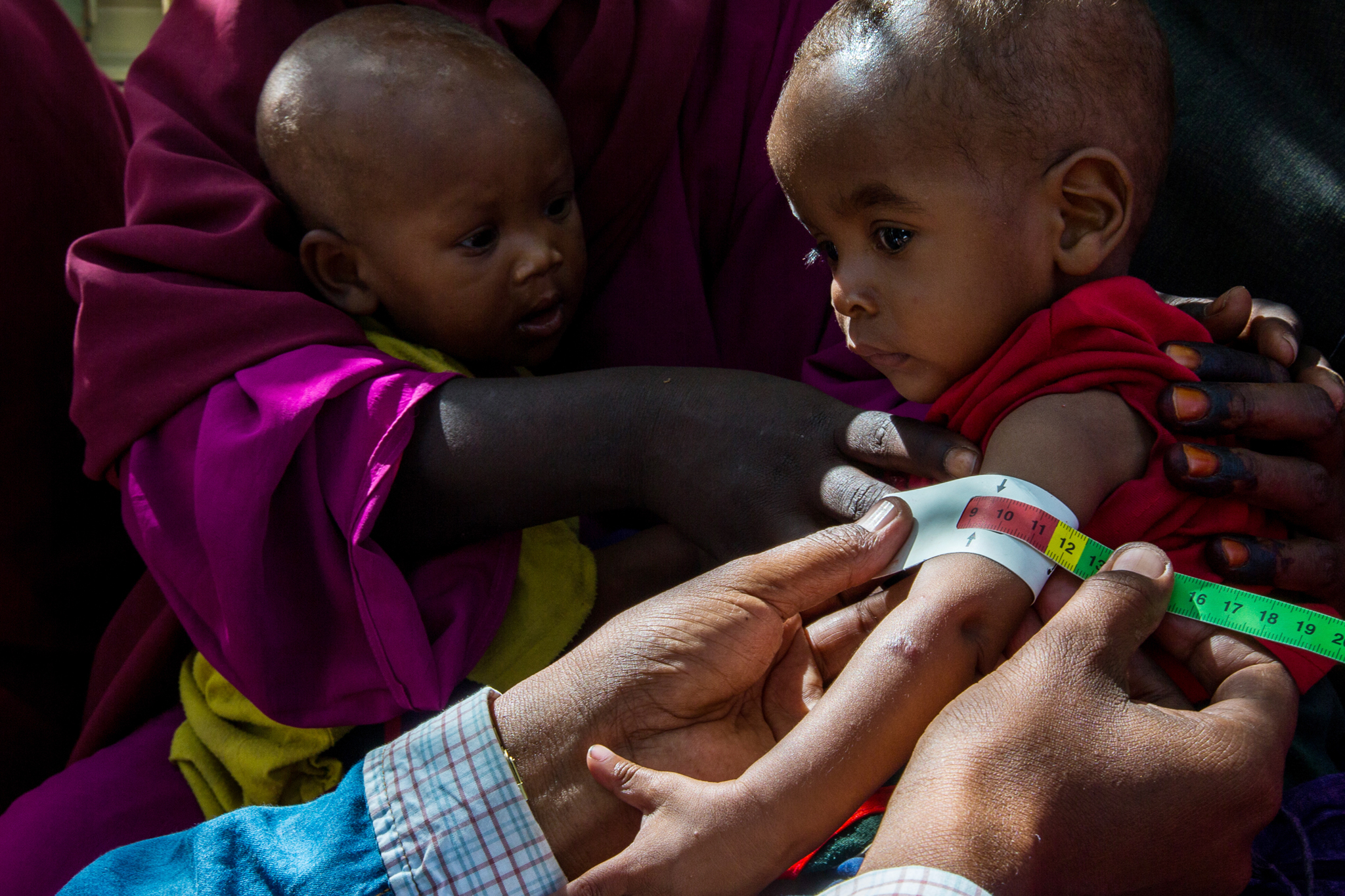Wasting is the most lethal form of malnutrition, but it is both treatable and preventable. Wasting is triggered by inadequate diet and recurring bouts of disease, such as diarrhea and malaria, leading to a weakened immune system and increased risk of death.
Unfortunately the economic and supply chain impacts of the COVID-19 pandemic and war in Ukraine have likely pushed the number of wasted children even higher. In many settings, climate change and conflict are also contributing to increasing numbers of wasted children.
The United States government announced an $11 billion commitment at the 2021 Nutrition for Growth Summit in Tokyo to support communities in crisis with critical emergency food and nutrition assistance. The investments will also help build resilient health systems and sustainable food systems to ultimately prevent more children from falling into malnutrition—actions that align with the priorities in the recently launched U.S. Government Global Nutrition Coordination Plan 2021-2026.

$200 million to scale up access to treatment
Additionally, the US government also committed to providing $200 million to scale up access to treatment, including Ready-to-Use-Therapeutic Food (RUTF)—the largest commitment ever made to treat wasted children. Nutrition partners are working to identify ways to use and deliver RUTF more efficiently.
$200 million to scale up access to treatment
Additionally, the US government also committed to providing $200 million to scale up access to treatment, including Ready-to-Use-Therapeutic Food (RUTF)—the largest commitment ever made to treat wasted children. Nutrition partners are working to identify ways to use and deliver RUTF more efficiently.

USAID Position Paper on Child Wasting
This position paper summarizes USAID’s commitment to addressing child wasting globally and approach to wasting programming and highlight areas for increased future investment. The paper focuses on global engagement and advancing the evidence base on child wasting; implementation of wasting prevention and management interventions; and the way forward.

USAID Multi-Sectoral Nutrition Strategy
The USAID Multi-sectoral Nutrition Strategy aims to reduce and maintain child wasting to under 5 percent through nutrition-specific interventions, including strengthening health systems.

Global Action Plan on Child Wasting
The Global Action Plan on Child Wasting (GAP) was jointly developed by five United Nations (UN) agencies, in consultation with a wide range of nutrition actors. USAID’s global commitments and the work of its partners are aligned with the GAP, which seeks to prevent and treat wasting by working through food, health, WASH, and social protection systems.

U.S. Government Global Nutrition Coordination Plan 2021-2026
The Global Nutrition Coordination Plan maximizes the impact of investments across the continuum of nutrition-related research, policies, programs, and other efforts to accelerate progress toward global nutrition goals. Wasting prevention and management is one of six priority areas for whole of government coordination under this plan.
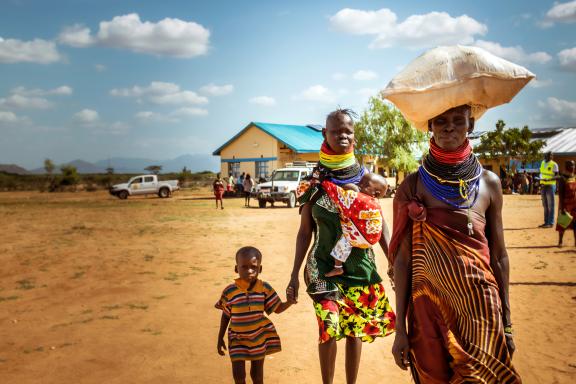
USAID Advancing Nutrition is documenting innovative ways to better prevent and treat wasting to minimize the consequences of wasting on child health.
USAID Advancing Nutrition is documenting innovative ways to better prevent and treat wasting to minimize the consequences of wasting on child health.
The causes and risk factors of wasting are multifaceted. While the goal is to prevent childhood wasting, children who are wasted need access to reliable treatment. Mitigating the impact of the immediate drivers of wasting, which include frequent illness and inadequate diets, is often thought to be the responsibility of the health sector. However, addressing its underlying causes requires a range of actions from those working beyond the health sector to ensure that households and communities have access to improved water, sanitation, and hygiene (WASH); social protection; and food systems.

Multi-sectoral approaches will not only reduce the burden of wasting but will contribute to improved nutrition, health, and overall well being.
USAID Advancing Nutrition has documented a wide range of preventive and treatment strategies that are contributing to improved wasting management and has also identified remaining challenges to be resolved.
Multi-sectoral approaches will not only reduce the burden of wasting but will contribute to improved nutrition, health, and overall well being.
USAID Advancing Nutrition has documented a wide range of preventive and treatment strategies that are contributing to improved wasting management and has also identified remaining challenges to be resolved.

Treatment of Moderate Wasting with Local Foods in the Nigeria, Senegal, and Uganda
We documented local food-based treatment approaches in Nigeria, Senegal, and Uganda to better understand how these approaches are implemented and factors that may contribute to their effectiveness.
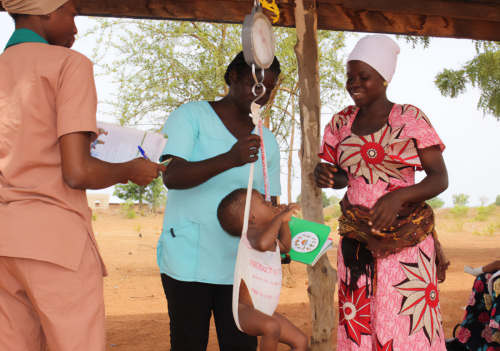
Training Health Workers to Tackle Wasting in Ghana
USAID Advancing Nutrition trained health workers in Ghana to strengthen their capacity to provide essential nutrition services, including community management of acute malnutrition, anemia prevention and control, outreach planning, and infant and young child feeding.

Strengthening the Continuum of Care for Wasting Management through Coordination and Collaboration: Findings from Facilitated Learning in the Democratic Republic of the Congo
Coordination and collaboration are critical to achieving a continuum of care for malnourished children that includes both prevention and treatment aspects of wasting management services and activities.

Blanket Supplementary Feeding in DRC: Findings from a Learning Activity
BSFP is one of the approaches commonly used to support food insecure households and is an important tool to prevent wasting in children under five and the deterioration of nutritional status of at-risk groups (e.g., pregnant and lactating women) during periods where food availability may be insufficient. We documented how BSFP is implemented in DRC and gathered global evidence on its effectiveness.

The Ready-to-Use Therapeutic Food Supply Chain in the Democratic Republic of the Congo: Analysis and Recommendations for Strengthening Last Mile Delivery in Kasaï Oriental and Nord Kivu Provinces
As part of efforts to understand and document the last mile delivery of this life-saving product to health facilities in DRC, USAID Advancing Nutrition studied four different RUTF supply chain pipelines. We sought to answer research questions related to pipeline structure and cost, stock availability, and key challenges.

Strengthening Wasting Management in Nigeria
This report documents the findings from a desk review and series of stakeholder consultations in Nigeria to identify ways to strengthen wasting treatment and prevention approaches in the country.

Nawiri Framework to Address Persistent Wasting
Implemented in partnership with the Government of Kenya in Marsabit, Isiolo, Samburu, and Turkana Counties, the USAID Nawiri program is a five-year initiative funded by the USAID Bureau for Humanitarian Assistance (BHA) to sustainably reduce persistent acute malnutrition in Kenya’s arid and semi-arid lands (ASALs).

Small-Quantity Lipid-Based Nutrient Supplement Program Implementation
This report describes a learning activity to 1) document the factors that promoted and/or hindered successful implementation of small-quantity lipid-based nutrient supplements (SQ-LNS) programs in highly food insecure contexts and 2) garner perspectives on considerations for scale-up. The activity was conducted in Honduras, Niger, and Somalia.
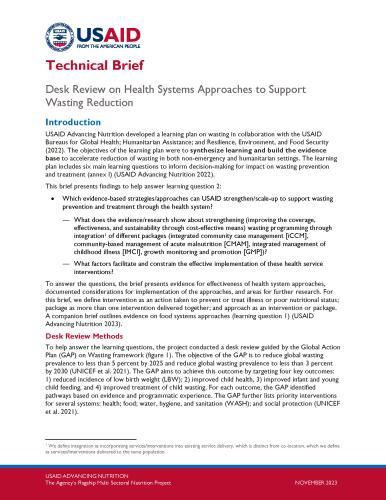
Health Systems Summary:
Guided by the Global Action Plan (GAP) on Wasting framework, this desk review presents evidence for effectiveness of health system approaches, documented considerations for implementation of the approaches, and areas for further research.
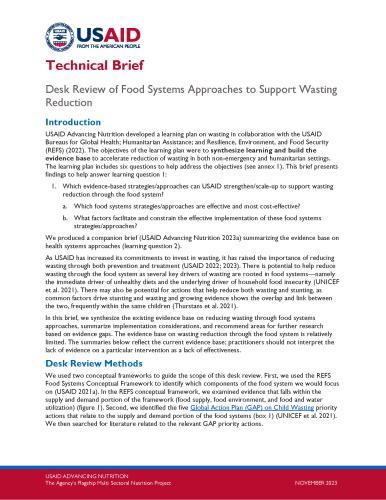
Food Systems Summary:
There is potential to help reduce wasting through the food system as several key drivers of wasting are rooted in food systems—namely the immediate driver of unhealthy diets and the underlying driver of household food insecurity. This brief, synthesizes the existing evidence base on reducing wasting through food systems approaches, summarize implementation considerations, and recommend areas for further research based on evidence gaps.
